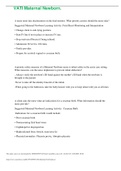Summary
Summary of lectures and book: Core theme Emotion
- Course
- Institution
- Book
This is a combined summary of the lectures and relevant book chapters as well as the assigned papers. It concerns the core theme course "Emotion" of the second year bachelor's programme.
[Show more]









